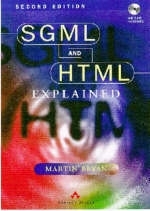
SGML and HTML Explained
Addison Wesley
978-0-201-40394-7 (ISBN)
- Titel ist leider vergriffen;
keine Neuauflage - Artikel merken
Fully updated to cover the latest features of SGML and HTML, this new edition of SGML: An Author's Guide now includes a detailed description of how the concepts of SGML are used in HTML. Building on the strengths of the previous edition, SGML and HTML Explained provides an accessible explanation of all the features provided by both languages through numerous practical examples. *Real world examples taken from the world of electronic publishing used throughout the book *A detailed description of the new standard HTML3 DTD including forms, Tables and Multimedia *An exploration of the SGML and HTML techniques that can be applied in document analysis and information modelling *A CD-ROM containing an interactive HTML example to enable readers to explore the real effects of Hypertext Links and other active HTML features.
*i.Foreword *ii.Preface 1.Background to SGML and HTML b *What is the Internet? *Interconnecting word processors *The role of markup *Types of markup *Specific markup *Generalized marku *The role of SGML *The role of HTML 2.Document Analysis and Information Modelling b *Identifying document types *The structure of documents *The structure of a memo *The structure of a letter *The structure of a report *The structure of scientific papers *The structure of book *Formatting structured documents *The difference between formatting and structure *Information management 3.The Components of an SGML System b *System components *Selecting an SGML document editor *The role of document analysis/design tools *The role of document conversion tools *The role of an SGML parser *Document databases and repositories *Printing SGML documents *Electronic delivery *The component parts of an SGML document 4.The SGML Declaration b *The role of the SGML declaration *The Syntax clause *The Reference Concrete Synta *Other clauses in the SGML declaration *The Character Set description *The Capacity Set *The Scope clause *The Features clause *Application-specific informatio *Alternative concrete syntaxes *The HTML SGML declaration 5.Elements and Attributes b *Element roles *Element declarations *Model groups *Text elements *Exceptions *Comments within element declarations *Ambiguous content models *Analysing content model *Using elements *Attributes *Declaring attributes *Using attributes *Simple attributes *Using tokens *Numeric attribute *Specialized attributes *Entity attributes *Unique identifiers *References to unique identifier *Controlling attribute values 6.Entity Declaration and Use b *Types of entity *Entity references *General entity references *Parameter entity reference *Entity declarations *Declaring parameter entities *Comments *Special forms of general entity declaratio *External entities *System-specific external entities *Alternative markup notations *Notation declarations *Data attribute *Publicly declared external entities *Requesting publicly declared external entities *Formal public identifier *Character references *Entity sets *Publicly declared entity sets *Private entity sets 7.Short References b *Introduction to short references *Short reference mapping declarations *Short reference use declarations *Using short references 8.Marked Sections and Processing Instructions b *The role of marked sections *Marked section declarations *Using marked sections *Ignored sections *Temporary sections *Combining keywords *Storing marked sections as entities *Nested marked section *Processing instructions *Using processing instructions in marked sections 9.Tag Minimization b *Types of minimization *Tag omission *Start-tag omission *End-tag omission *Omitting tag *Short tags *Empty tags *Unclosed tags *Null end-tags *Omitting attribute name *Tag grouping (rank) *Automatic tag recognition (data tags) 10.Multiple Document Structures (SUBDOC, CONCUR and LINK) b *Types of multiple document structures *SGML subdocuments *Concurrent document structures *Linking document structures *Simple links *Implicit links *ID-specific links *Explicit links *Using alternative link set *USELINK *POSTLIN *Short cuts *Overriding link declarations *Using publicly declared link type declaration subsets 11.Building a Document Type Definition b *The Document Type Declaration *Using publicly declared document type declarations *Element sets *The role of comment declarations *Modifying existing element and entity sets *Creating new element sets *Structured element set *The effect of record boundaries 12.Interpreting the HTML DTD b *DTD history *DTD identification *Deprecated features *Imported Internet specifications *Shared parameters *Character mnemonics *Generic attributes *Text markup *Shared content models *Body components *Anchors and Links *Images and Maps *Objects and Applets *Paragraphs and Headings *Preformatted text *Lists *Forms *Tables *HTML Document Headers *HTML Document Structure 13.The HyperText Markup Language b *The HTML Header *Text Blocks in the HTML Body *Space delimited text blocks (%block) *Lists *Preformatted and quoted text *The DIVison element *Other elements deifnes as block *Embedded Text *The Role of HTML Anchors *Link relationships *Link Management in an HTML Environmen *Images and Maps *Tables *Applets and objects 14.Creating HTML forms b *Basic principles *The FORM element *The INPUT element *Text input *Password input *Checkboxes *Radio buttons *User-defined buttons *Submit button *Reset button *Hidden input *File selection *Image spot selectio *The SELECT element *The TEXTAREA element *The FIELDSET element *The LABEL element *The ISINDEX element *Form submission *Form processing 15.The Future for SGML and HTML b *What DSSSL brought to SGML *SGML groves *The SGML Document Query Languag *The HyTime SGML General Facilities annex *Architectural Form Definition Requirements *Formal System Identifiers *Property Set Definition Requirement *Possible extensions to SGML *Possible extensions to HTML I.Index
| Erscheint lt. Verlag | 15.4.1997 |
|---|---|
| Verlagsort | Boston |
| Sprache | englisch |
| Maße | 156 x 233 mm |
| Gewicht | 360 g |
| Themenwelt | Informatik ► Netzwerke ► Mail Server |
| Mathematik / Informatik ► Informatik ► Web / Internet | |
| ISBN-10 | 0-201-40394-3 / 0201403943 |
| ISBN-13 | 978-0-201-40394-7 / 9780201403947 |
| Zustand | Neuware |
| Haben Sie eine Frage zum Produkt? |